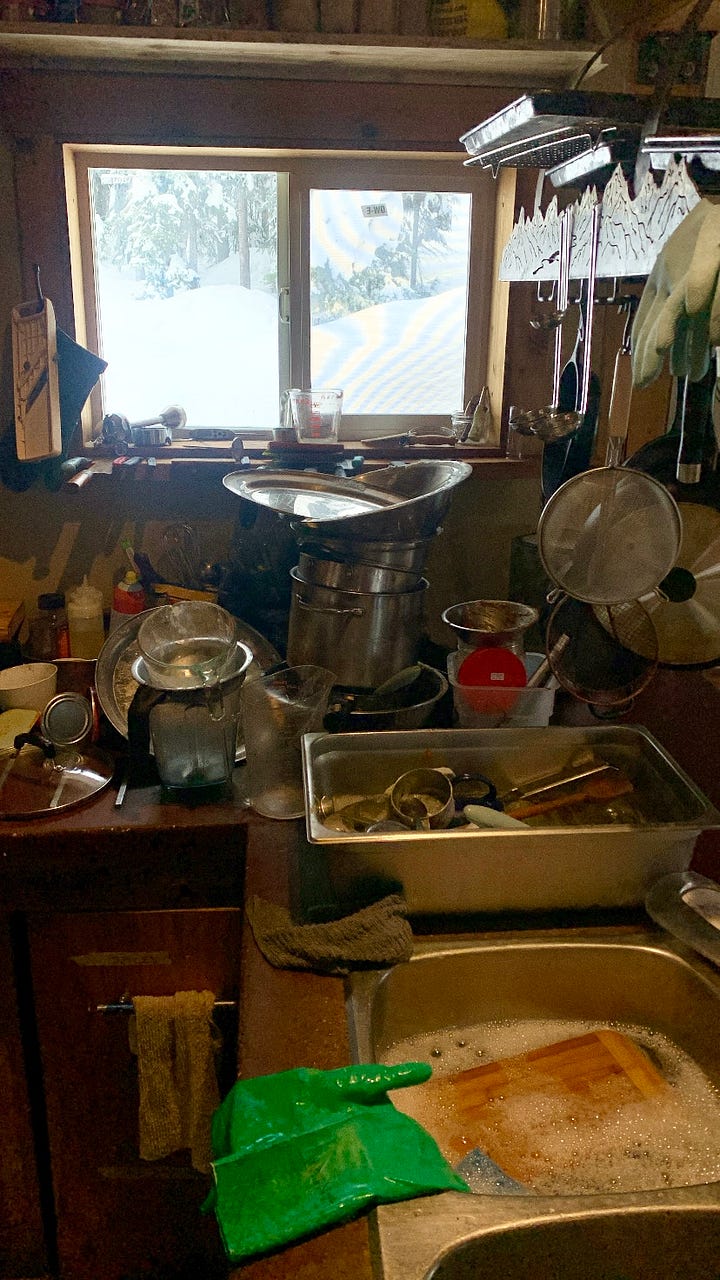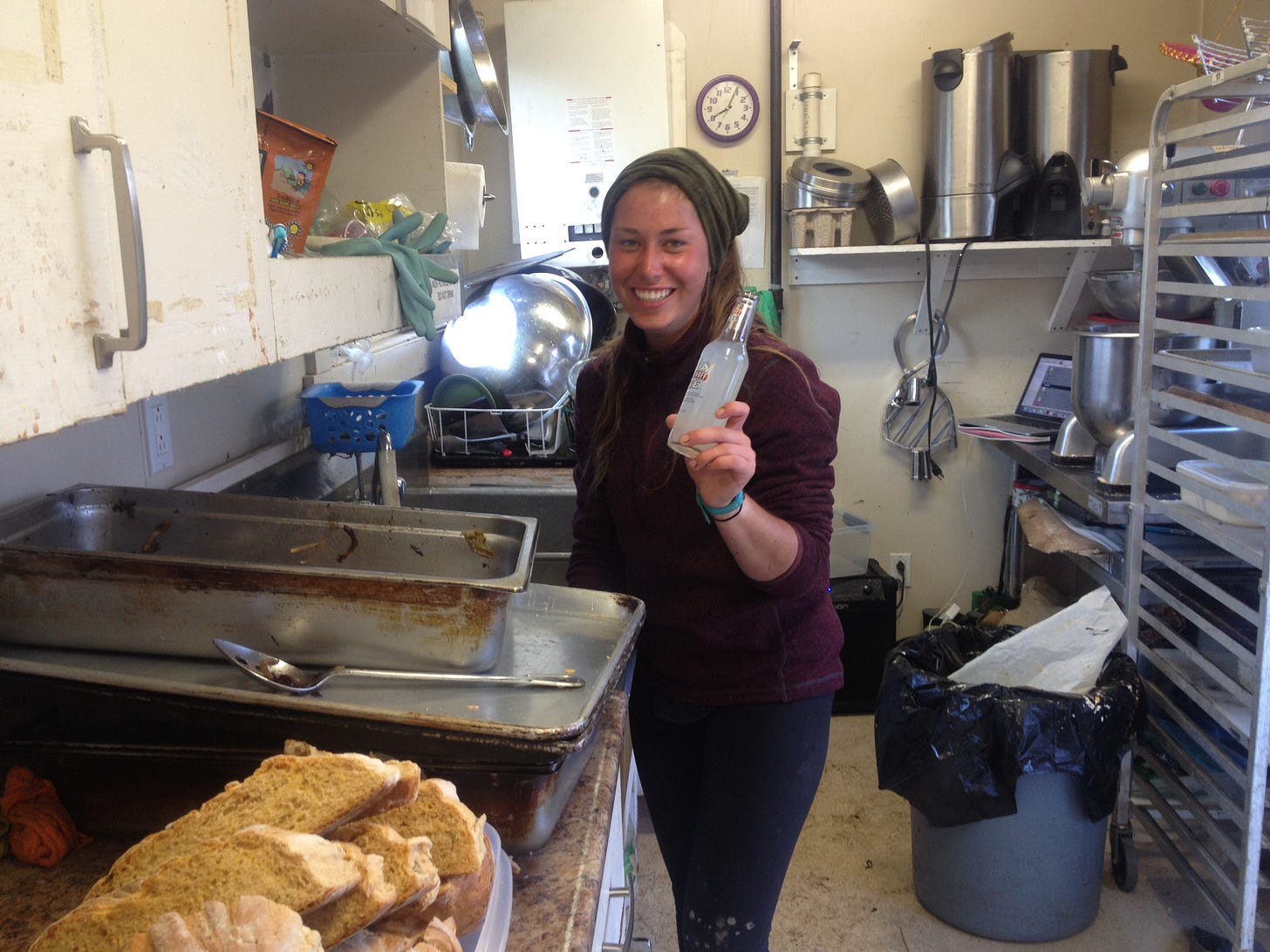If the stove is the heart of my backcountry kitchens, the dish pit is the backbone. Because behind every dessert, loaf of bread, massive salad and full blown dinner I serve, there are dozens of dishes that have been scrubbed. And after a meal is eaten and stories from the day are shared, there are more dishes to do. And when I return to the kitchen at 5 am, there is a trickle of wine glasses and dessert plates that weren’t there when I clocked out. Doing mountains of dishes is the price we pay for doing lots of eating in the backcountry, and the dish pit is the indispensable engine that helps to keep everyone fed.
In every kitchen I have worked in, the dishes have been done by hand. And not only are they done by hand, but there is never a designated paid dishwashing position. The dishes are part of the cook’s job description, and so us cooks do a lot of dishes. But I don’t mind. Because a good session in the pit serves as a natural mental pause within my busy day of cooking. The feeling of satisfaction I get is weirdly strong as I slowly make my way through a teetering pile of dirty dishes, transferring each item through hot soapy water, before dunking it in the rinse water and adding it to my strategically built tower of sparkling clean dishes. The gleaming pile is evidence of a busy day in the kitchen; the cakes cooling in the window, the cookies neatly packaged, the soup simmering on the stove, and the dinner roasting in the oven.
My introduction to a commercial dish pit was during my first spring in a tree planting camp. I arrived to a cook shack with two cooks in it. After about an hour in to my first day, I realized I wasn’t there to assist with the cooking, I was there to do dishes for the 140 person camp. And there was a shit ton of them. The days were 16 hours long and I did dishes the entire time using three sinks and no commercial dishwasher, until the camps split into their smaller sections. Doing dishes quickly literally equated to being able to sleep more, so I figured out my systems and worked fast. Those weeks in the dish pit were life altering; they made me efficient, strategic, and most importantly, unafraid of any amount of dishes that needed doing, a mindset that has served me well as I have cooked and done dishes in different settings.
But over the years, I have had some help with the dishes. And if I receive assistance with this critical task, it’s usually from another cook taking a turn, a friend coming to hangout after a long day, a lodge guest, a ski guide, kayak guide, hiking guide or fishing guide, a wwoofer, an owner, an injured tree planter, a friend of an owner, or a crew boss trying to hit on me or one of my kitchen staff. Though I don’t mind doing them, I will always accept help with the dishes, even if I have to listen to some guy try to woo my co cook by telling her how many trees he planted that day or how he unstuck a quad from a muddy hole. Help with the dishes is the single best way to support a busy kitchen, and I am always stoked to welcome a new volunteer to the pit.
Having some backup on dishes is not only incredibly helpful, it means I’ve gotten to know a lot of random people at lightning speed. Because my kitchens are small, and when someone is in my dish pit, they are a part of my kitchen. I move around them while mixing, stirring, chopping and kneading as they stand in the same spot and scrub away. While focused on our individual tasks, we often get to chatting. Usually it starts with the simple stuff, where are they from, how did they end up here. But it always gets deeper. Do they have kids, where do their siblings live, what do they do for work, do they find it fulfilling. How do they like to spend their time, what is their hometown like, who are the important people in their lives. People share with me what it means to be in the mountains, to share these special places with their friends, and how they’ll cherish their memories when they go back to work on Monday. We might even keep in touch, and sometimes years go by and then they join me in my dish pit again after sharing another meal together.
As willing as I am to accept help from anyone who offers it, there really are two types of dishwashers in this world: those who have worked a dish pit, and those who haven’t. You can always spot a person who has worked one, whether it was while they were guiding river trips up north or working in the back of a restaurant. A seasoned dishwasher is methodical, organized, and most importantly, thorough. As in, the dishes are clean when they are done with them. They usually reach for a speaker before they reach for the hot water, because they know that music will help the cause. They wear dish gloves because they understand the water is best when its hot, and, I can’t emphasize this enough, they clean the bottom of the dishes too, not just the inside. Any help with the dishes is amazing, but having a seasoned dishwasher take the lead is truly a blessing!
And the dishes are always present. They pile up throughout every part of the day, and even if I just did a 30 minute round, it will take about 30 seconds for the next dirty dish to appear next to the sink I just drained. Cups, mugs, plates, cutlery, pans, pots, knives, cutting boards, mixing bowls, measuring spoons, cake pans, peelers, tongs, trays, wooden spoons, spatulas, whisks, Tupperware, blenders, and colanders stack on top of each other haphazardly next to the dish pit. They await their turn to be washed and put back in to their places, just in time for me to reach for them again. The rhythm of the dish pit beats throughout the day, splashes of water, sounds of scrubbing, plugs being pulled, grey water spilling into the pipes below, and that signature slurping sound of a draining sink echoes across the kitchen.
A never ending need for clean dishes results in a never ending need for hot water. And the process of ensuring hot water arrives in my dish pit has been carefully thought out by owners and supervisors, as each backcountry location has a unique way of gathering water for their kitchens. In all kitchens though, water comes from a nearby lake, river, stream or natural spring. Most often, it requires a steady supply of gasoline to fuel pumps and generators to fill holding tanks, and once the water is pumped it still needs to be heated, which requires propane to be burned and wood stoves to be stoked. Every drop of hot water is precious in the backcountry, and it’s journey to my sinks does not go unrecognized as I fill them multiple times throughout the day.
No time is it’s value more evident than when something goes wrong with the dish pit. Like in early May and late September, when water lines freeze at night as temps get down to zero, leaving my taps dry when I hit the kitchen early in the morning. This is less than ideal when making pancakes for 65 people, while sticky batter coats the counter top, mixing bowls, whisks and measuring cups as I scoop pancake after pancake onto the flat top. When I reach for the taps and no water comes out I look at the frost on the tents outside and realize why. Knowing there won’t be any running water until the sun hits the lines at 10 am, I wipe my hands on my apron, grab a 40 litre stock pot and head outside to the water tank to manually fill the pot. I’ll carry it back to the cook shack, hall it up the stairs, and strong man it onto the stove to warm it up for my dishes. I am reminded again to never take a functioning dish pit for granted.
Cooking and baking dozens of things each day requires a lot of hot soapy water and manual labour. No bottleneck in the kitchen is greater than a backed up dish pit. So if you’re reading this as someone who has put in a shift in one of my dish pits, thank you! And thanks for reading.









An insightful, sudsy piece of writing! Enjoyed it.
I’ve done a few. 😉💕 Always happy to support the cook.